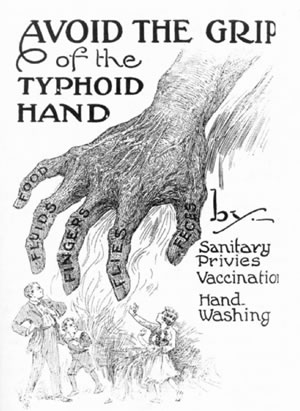Health and Sanitation
Disease and the Working Poor
 Sanitation for tenants on Front Street, as for most Americans in the late
nineteenth and early twentieth centuries, was poor and relied on traditional
practices. Persistence of traditional hygiene/sanitation was influenced
by socioeconomic status and upper-middle-class stereotypes that stymied
sanitation reform and offered the working classes few options. Attitudes
about public health changed over the course of the nineteenth century, but
the association of disease with the less affluent lingered in the minds
of the upper class. During the early part of that century, disease was perceived
as an affliction of those who lacked virtue, piety, and morality. As urban
America grew, this perception gave way to the notion that offensive odor,
or “miasma,” was the culprit, brought about by close living and
reckless sanitary habits. Miasmas were commonly viewed as transmitters of
disease. “Out of sight, out of mind” (and smell) became a widely
held belief and practice. Later on, though, the development of germ theory
and health reforms after the Civil War brought about major sanitary improvements
by the close of the nineteenth century. In 1899, Dr. G. S. Franklin wrote
“Sanitary Care of Privies,” an article outlining a strategy to
combat typhoid fever (also known as nightsoil fever) and other centric diseases
caused by poor sanitation. He promoted sewer systems instead of privies
(earth closets). If sewers proved too costly, privies should at least use
of impervious containers such as pails, tubs, and [lined] earth closets.
Earth closets should be properly lined to prevent leakage, and deodorants
and disinfectants should be added to control odor and help prevent the spread
of disease (Carnes-McNaughton and Harper
2000:103). Even though advances in understanding the cause and spread
of disease were made during the late nineteenth and early twentieth centuries,
earlier misconceptions combined with new information about disease to perpetuate
attitudes about the health of the working poor, and this had a profound
effect on sanitary developments on Front Street over two generations.
Sanitation for tenants on Front Street, as for most Americans in the late
nineteenth and early twentieth centuries, was poor and relied on traditional
practices. Persistence of traditional hygiene/sanitation was influenced
by socioeconomic status and upper-middle-class stereotypes that stymied
sanitation reform and offered the working classes few options. Attitudes
about public health changed over the course of the nineteenth century, but
the association of disease with the less affluent lingered in the minds
of the upper class. During the early part of that century, disease was perceived
as an affliction of those who lacked virtue, piety, and morality. As urban
America grew, this perception gave way to the notion that offensive odor,
or “miasma,” was the culprit, brought about by close living and
reckless sanitary habits. Miasmas were commonly viewed as transmitters of
disease. “Out of sight, out of mind” (and smell) became a widely
held belief and practice. Later on, though, the development of germ theory
and health reforms after the Civil War brought about major sanitary improvements
by the close of the nineteenth century. In 1899, Dr. G. S. Franklin wrote
“Sanitary Care of Privies,” an article outlining a strategy to
combat typhoid fever (also known as nightsoil fever) and other centric diseases
caused by poor sanitation. He promoted sewer systems instead of privies
(earth closets). If sewers proved too costly, privies should at least use
of impervious containers such as pails, tubs, and [lined] earth closets.
Earth closets should be properly lined to prevent leakage, and deodorants
and disinfectants should be added to control odor and help prevent the spread
of disease (Carnes-McNaughton and Harper
2000:103). Even though advances in understanding the cause and spread
of disease were made during the late nineteenth and early twentieth centuries,
earlier misconceptions combined with new information about disease to perpetuate
attitudes about the health of the working poor, and this had a profound
effect on sanitary developments on Front Street over two generations.
The reality of life for most textile workers in the South in the late nineteenth and early twentieth centuries was poverty. This condition was eased for some by steady wages and income brought about by multiple family members at work, but for many households it often had a dramatic effect on health (Beardsley 1987). Poverty was the root of parasitic and nutritional deficiency diseases, “especially in industrial communities where the entire population were on the margin of subsistence” (Roe 1973:107). Acute poverty and disease in this region during the early twentieth century prompted landmark health studies (Beardsley 1987; Goldenberger 1964; Roe 1973). Several of these studies focused on a particularly devastating (and fatal) disease common among the poor known as pellagra.
 Skip to main content
Skip to main content
